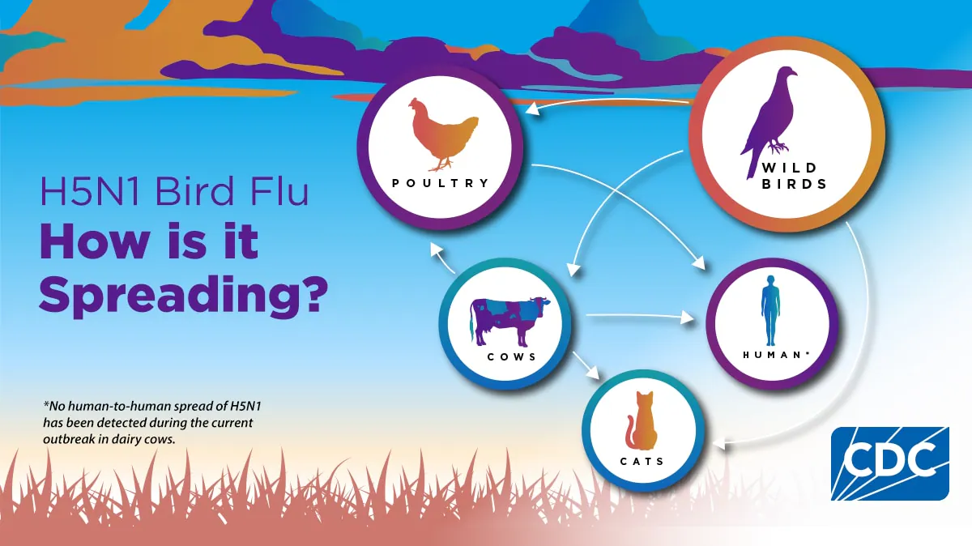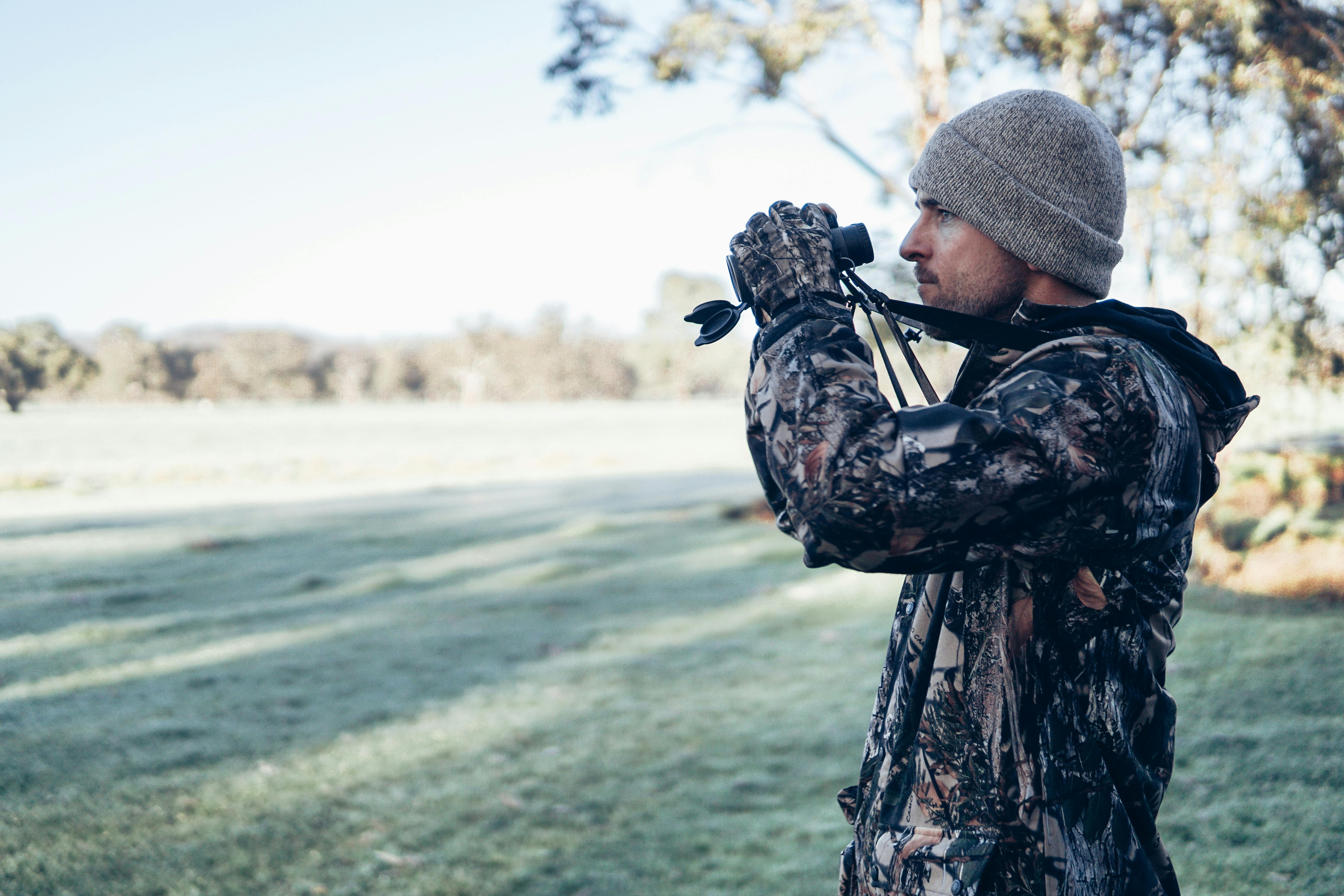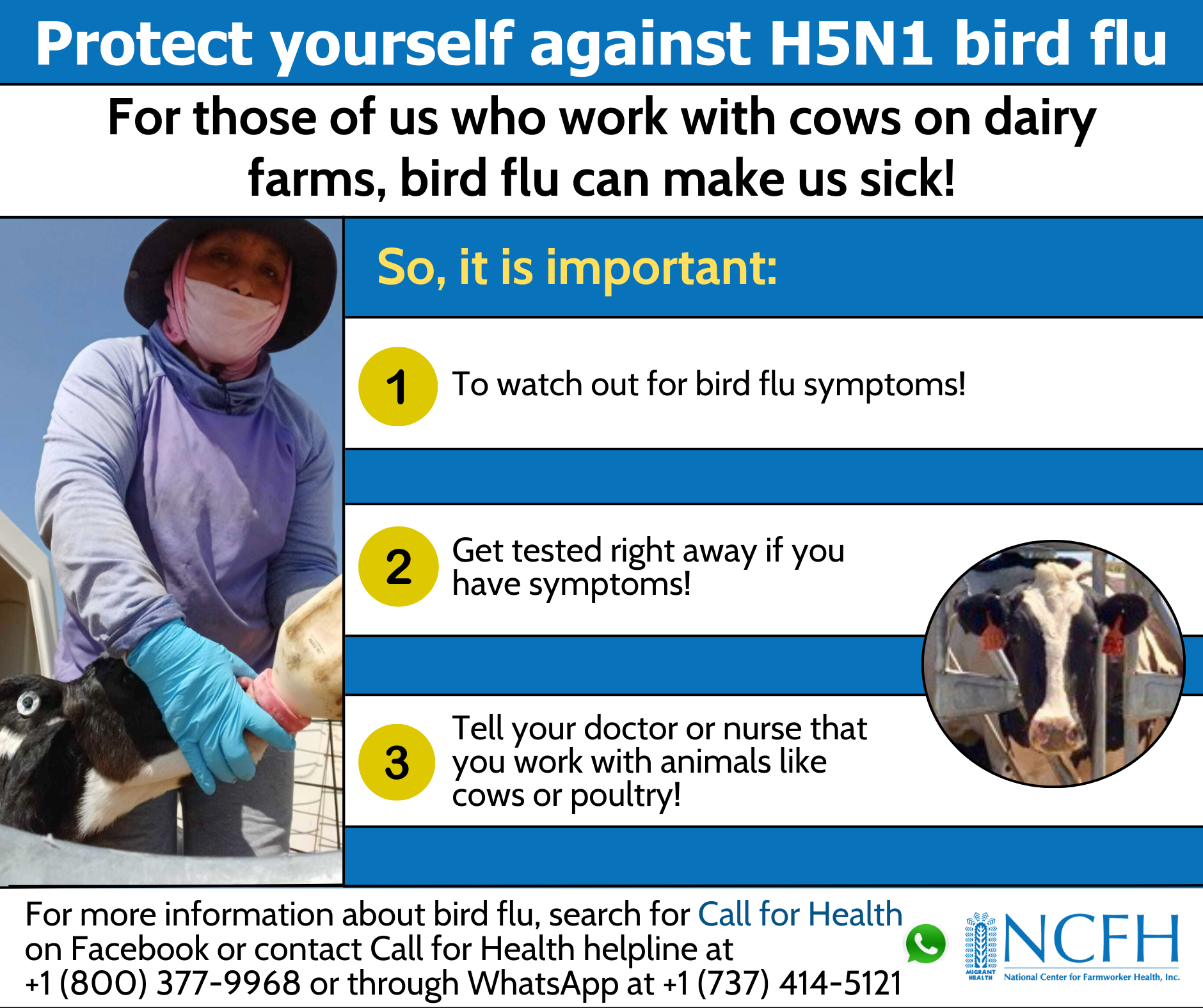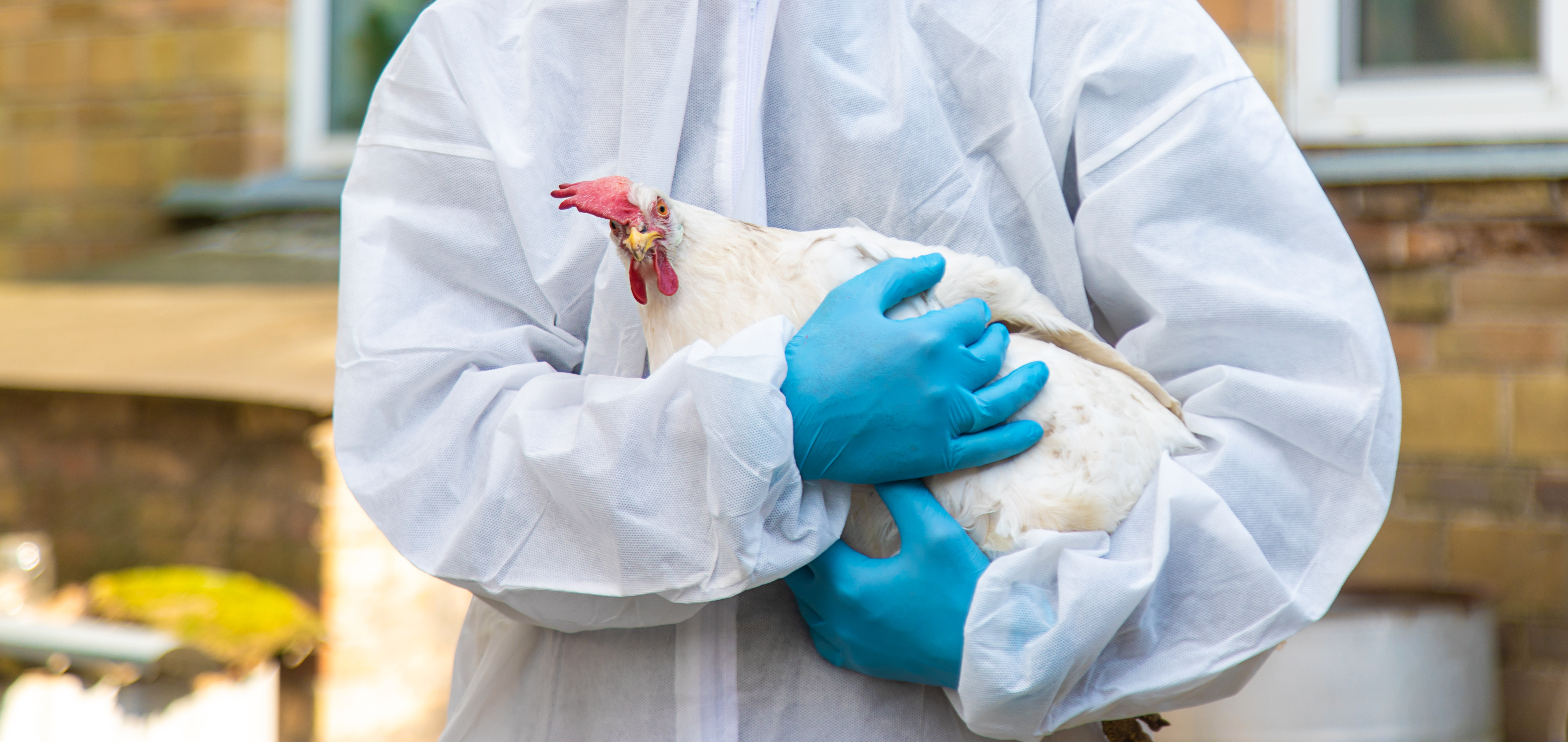Bird Flu
- As of March 5, 2025, person-to-person spread of H5 bird flu has not been identified. The current H5N1 bird flu risk to the general public remains low. People with job- or recreation-related exposures to infected animals are at increased risk, especially when those exposures happen without use of appropriate personal protective equipment. View the updated risk assessment on the CDC website.
Go to: Recommendations for Residents | Food Safety | Signs & Symptoms
- As part of a February 24 bird flu response update*, CDC noted that it has confirmed three human cases of H5 bird flu in people who became ill in 2025: a dairy worker with exposure to infected dairy cows (Nevada*), a poultry worker with exposure to infected commercial poultry (Ohio*), and the owner of an infected backyard poultry flock (Wyoming*). These are all considered higher-risk exposures*.
Bird flu (avian influenza) is caused by viruses that mostly infect birds. However, some strains (such as HPAI) can also infect other animals and humans. Birds and other animals infected with avian influenza shed the virus in their saliva, mucus, and poop.
People can become infected if the virus is breathed in or gets into a person’s eyes, nose, or mouth after touching contaminated surfaces or materials.
- Avian influenza
- H5N1
- Highly Pathogenic Avian Influenza (HPAI)

Recommendations for Sedgwick County Residents
General Public (Updated)
- Avoid wild birds and only observe them from a distance.
- Avoid contact with poultry, wild birds, and other animals that appear ill or are dead, as well as contact with surfaces that may have been contaminated with their feces.
- Avoid eating uncooked or undercooked poultry, meat, and eggs.
- Cook poultry, meat, and eggs to the right internal temperature to kill bacteria and viruses, including H5N1 viruses.
- Drink pasteurized milk that has been treated to kill harmful bacteria.
- Avoid touching or drinking raw milk or raw milk products, especially from animals with confirmed or suspected avian flu infection.
- Wash your hands and surfaces thoroughly before and after handling poultry, meat, and eggs.
Backyard flock owners can learn more about protecting their domestic poultry here.*
If you have a backyard poultry flock, ensure that your biosecurity practices are in place.
This includes:
- Keeping your poultry house clean
- Separating your flock from wild birds. For example, using an enclosed shelter
- Separating new birds from your existing flock for at least 30 days
- Not sharing equipment with other bird owners
For additional information about biosecurity practices, visit the Defend the Flock Resource Center*.

Click here to view the above image in Espanol.
If you have sustained contact with poultry, dairy cattle, or livestock, take the following actions to minimize the risk of H5N1 bird flu exposure for yourself, your team, and the people in your community:
- Watch for sick or dead animals
- Monitor animals for health-related changes
- Learn how to properly put on, wear, remove, and reuse or dispose of PPE*.
- Do not touch sick or dead birds, their feces or litter, or any water source that may be contaminated with their bodily fluids without wearing PPE.
- Wash hands thoroughly with soap and water or an alcohol-based hand sanitizer after contact with birds and other animals.
- Avoid touching one’s own eyes, nose, and mouth after direct contact.
For additional information, refer to the guidance* from the CDC.
Hunters who handle wild birds should dress game birds in the field when possible and practice good hygiene to prevent any potential disease spread.
- Do not handle or eat sick game.
- Wear rubber or disposable latex gloves while handling and cleaning game.
- When done handling game, wash hands thoroughly with soap or disinfectant, and clean knives, equipment, and surfaces that came in contact with game.
- Do not eat, drink, or smoke while handling animals.
- All game should be thoroughly cooked to an internal temperature of 165 degrees F before being consumed.

More information on general safety guidelines for hunters handling wildlife and their tissues* is available from the U.S. Fish & Wildlife Service's website.
There are no current travel restrictions* to any countries due to bird flu.
Travelers who are visiting areas with known HPAI outbreaks should:
- Avoid poultry farms or places where live poultry are raised unless wearing personal protective equipment (PPE)
- Avoid contact with animals in live food markets, and any surfaces that appear to have poultry poop on them
- Avoid dairy farms with sick cows, unless wearing personal protective equipment (PPE)

Food Safety
(Updated 2/27/2025)
However, it is always best to follow safe food handling practices.
- Do not eat uncooked or undercooked poultry or beef or drink unpasteurized (raw) milk.
- Cook poultry, eggs, and beef to the appropriate internal temperature to kill bacteria and viruses.
- Wash your hands and surfaces thoroughly before and after handling poultry, meat, and eggs.
- Choosing pasteurized milk and products, such as including soft cheese, ice cream, and yogurt made with pasteurized milk is the best way to keep you and your family safe.
For additional information about Food Safety and Bird Flu*, click on the link to visit the CDC's website.
- Red eyes (conjunctivitis)
- Fever (100 degrees Fahrenheit
or more) - Cough
- Sore throat
- Runny/stuffy nose
- Muscle or body aches
- Headaches
- Fatigue
- Difficult breathing
- Pneumonia
- Less common symptoms
include diarrhea, nausea,
vomiting, and seizures.
- Poor appetite
- Reduced milk production
- Abnormal milk (thickened or
discolored) - Clear nasal discharge
- Respiratory symptoms like wheezing and coughing
- Neurological symptoms like blindness, seizures, or tremors
- Excessive discharge from the eyes or nose
- Mood changes
*If you suspect your cat has bird flu, contact your veterinarian and limit its exposure to other cats, birds, or humans.
- Sudden death
- Low energy
- Poor appetite
- Purple discoloration or
swelling of different body parts - Reduced egg production
- Abnormal eggs (misshapen or
soft shells) - Nasal discharge
- Coughing
- Sneezing
- Lack of coordination
- Diarrhea
Source (s):
- National Center for Farmworker Health, Inc. (NCFH)*: https://www.ncfh.org/infectious-disease-hub/h5n1-birdflu-resources
- Center for Disease Control and Prevention (CDC)*: https://www.cdc.gov/bird-flu/situation-summary/index.html
- U.S. Fish & Wildlife Service*: https://www.fws.gov/avian-influenza
- H5N1 Bird Flu Archives - Public Health Communications Collaborative*: https://publichealthcollaborative.org/topics/h5n1-bird-flu/
* Link opens to external, government website.



